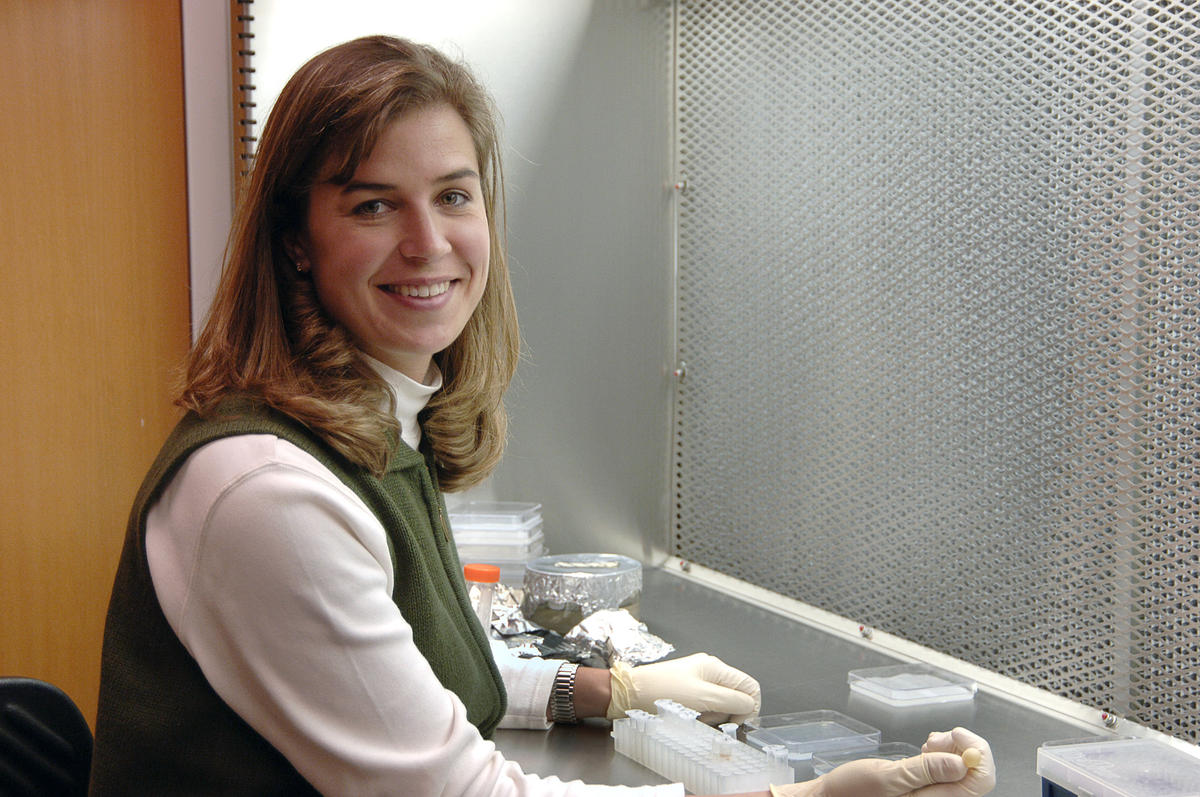News Releases on Identification of a Resistance Gene to Soybean Cyst Nematode:
1. From the University of Missouri

“Nine years ago, when I began investigating the molecular basis of soybean resistance to nematodes in an effort to identify the genes involved, I never imagined it would be this complex,” says Melissa Mitchum, co-author of the paper and associate professor of plant sciences at the Univ. of Missouri’s Bond Life Sciences Center. “The gene responsible for nematode resistance was completely unexpected. The gene, called serine hydroxymethyltransferase (SHMT), is common in nature and found in different kingdoms including both animals and plants. In humans, mutations in the SHMT gene can lead to a deficiency of folate, a B vitamin that is essential to the production and maintenance of cells, and this has been linked to a variety of diseases.”
Mitchum and her team collaborated with Khalid Meksem’s group at Southern Illinois University to pinpoint the location of the gene in the soybean genome. They then identified soybean plants from a normally resistant variety, but with a mutated form of the SHMT gene. They observed that these plants had lost resistance to nematodes. In another experiment, the SHMT gene was shut down using two different gene-silencing techniques. These soybeans also became susceptible. A third test put the resistant form of the SHMT gene into normally susceptible soybeans and found that these plants also became resistant.
“Plant breeders can put our results to use immediately,” Mitchum says. “We now know which genes to look for when breeding resistant varieties. Nematode resistance also can now be directly inserted into commercially important breeds of soybean. For farmers, developing new forms of resistance to SCN in soybeans can’t come soon enough. Nematodes are developing their own ways around natural defenses. “Hopefully, our discovery has paved the way to enhance the durability of resistant varieties of soybean.”
Although plant breeders can use Mitchum’s discovery now, it may be another decade before she and her team discerns the technicalities of nematode resistance. So far, they know that two mutations in the SHMT gene alter the enzyme’s activity in such a way to provide resistance to the plant. Together with Dmitry Korkin’s group, they found that the deformed enzyme malfunctions, particularly in regions of the enzyme known as the binding pockets, where the enzyme interacts with other molecules. Exactly how this affects the nematode is still unclear.
2. Putting it into a larger persepctive:
From Jack Kaskey, Bloomberg News, October 15, 2012
Scientists have identified a soybean gene responsible for making some varieties resistant to the cyst nematode, a pest responsible for $1 billion in annual crop losses.
The gene wards off nematodes by making an enzyme that starves the pest or acts as a natural pesticide, according to a paper released today in the journal Nature. The study is the first to identify the gene and its mechanism for creating resistance, said lead authors Melissa Mitchum of the University of Missouri in Columbia and Khalid Meksem of Southern Illinois University in Carbondale.
The soybean cyst nematode can cut crop yields 50 percent and cause $1 billion in losses in the $42.2 billion annual U.S. crop, making it the top soybean pathogen, Greg Tylka, a plant pathology professor at Iowa State University. Knowing which gene is responsible for natural resistance will help breeders identify the hardiest varieties and could lead to genetically modified soybeans with complete resistance, he said.
“This could speed up breeding for soybean cyst nematode resistance by a quantum leap,” Tylka, who wasn’t involved with the Nature study, said today by telephone from Ames, Iowa. “It will allow traditional breeding to be very precise.”
The soybean cyst nematode starts life as a microscopic worm that burrows into soybean roots, where the female feeds and swells into a leathery, lemon-sized cyst full of eggs. The eggs are “time released,” hatching over the course of a decade or more, so rotation with other crops does little to eradicate the pests from a field, Tylka said.
Asian Import
Soybeans have been bred to resist the cyst nematode, an import from Asia, since it was first discovered in the U.S. in 1954, Tylka said. Resistant varieties remain imperfect, with damage occurring to varying degrees depending on the plant and the type of cyst nematode in the field, he said.
Identification of a second soybean gene for cyst nematode resistance is needed before plants can be created that offer complete resistance, Tylka said. In the near term, researchers may want to focus on how the newly discovered enzyme-producing gene confers resistance.
In addition to breeding soybeans for resistance to nematodes, Monsanto Co., the world’s biggest seed company, has an early-stage research project on a bean that is genetically modified to resist the pest, Sara E. Miller, a spokeswoman for the St. Louis-based company, said in an e-mail. Monsanto, which in 2008 made public its sequence of the soybean cyst nematode genome, also is developing a seed treatment to control nematodes, she said.